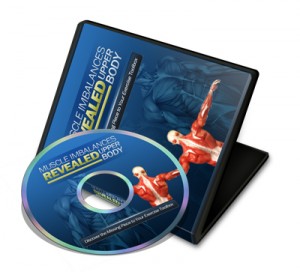Fascia and Its' Role In Making You a Pain-Free Beast
I had a new client come in to see me the other day (young guy, early mid twenties) who had complained about chronic shoulder pain for the past few years. Nothing serious, just a dull ache through the region, feeling like a band running from the front of the shoulder to the back over the top of the acromion, and it felt “tight.”
No surprise his posture was more jacked up than Gary Busey’s teeth: shoulders were rolled in, back hunched, head was forward, affected shoulder was raised, and on top of that he had fallen arches and all the ankle mobility of a clam. His shoulder joint tested normal with no painful passive movements, he had a lot of restrictions through anything active involving overhead or external rotation positions, but no pain. So instead of working on his shoulder, I started to work on his feet and ankles, then had him spend about 10 minutes trying to get his squat to work properly without making my eyes want to bleed.
I retested his shoulder, and to his amazement, the voodoo of fixing the ankles and feet along with improving squat mechanics reduced the tightness in his shoulder, and resulted in a dramatic increase in range of motion.
Another client with chronic low back pain that again was just a “dull ache” had a big reduction in symptoms simply by drinking an extra litre of clean water each day. Another client saw big reductions in knee pain and massive improvements in range of motion for squats by simply running their bare foot over a golf ball on the floor. Another client had a complete reduction in neck pain by using a foam roller on their IT band.
Crazy, I know, because it’s not what we’ve always thought of as directed interventions for specific issues. If you have a shoulder problem, then do stuff to the shoulder, right?
Using that analogy is like saying you’re going to replace the nozzle at the end of the hose every time you squeeze the trigger and water doesn’t come out. Maybe there’s a kink in the line, or maybe the water is simply turned off, but all you’re looking at is the fact that water isn’t coming out of the end of the hose, which means it MUST be the nozzle, right?
Let’s face it, fascia is a term that gets thrown around a lot but isn’t really all that understood by many people in the fitness industry. It’s sort of like the Republican candidates and birth control: they’ve heard of it but don’t quite know what it does or what it’s used for, or even where they should come in on the matter.
I’ve heard fascia described as everything from cotton batting to a ziploc baggie that holds the muscle to useless spare tissue and everything in between. I’ve heard you should roll it, push on it, stretch it, tighten it, and all number of contradictory statements. When I was in university, my professors called fascia “connective tissue” and left it at that. No discussion on its’ connective properties, relative strength, ability to remodel under strain, proprioceptive nature, nada. In other words I had to get my learn on outside of school, and found out how important this tissue actually is for fitness and health improvement overall.
Fascia is primarily made of of dense collagen and elastin fibres to form a connective matrix that helps to wrap pretty much each part of the body. It entwines with the bones, muscles, muscle fibres, blood vessels, organs, layers of tissues, and even provides a point of anchoring for things like finger nails and hair follicles.
Fascia is also ridiculously strong. Comparing it’s tensile strength of 2000 psi to that of an ACL, which is 4700psi in healthy individuals, and combine that with the fact that it’s literally everywhere and in dense layers, you can see how much of a role it can play to the development of strength and stability through the system.
Fascia is also incredibly neurally dense, with a lot of innervation from both sensory and motor units, which means it can feel what kinds of tension are present, how fast or slow movement occurs, and what level of strain is being applied to the system. It can also carry an electrical charge and produce some contraction, which is why you can feel an area of your body become “tight” even if there are no specific muscles involved in that area. Think of someone laying on their stomach on a massage table, their back muscles aren’t engaged much at all, but the resting tension is almost primarily coming from the fascia through the lumbodorsal region holding tight. The fact that it actually has some smooth muscle cells embedded into its’ matrix that pulls fascial fibres together should raise some eyebrows as to its’ contractile properties, especially since smooth muscle isn’t under conscious control.
Fascia contains a few types of receptors not found anywhere else. It has 17 different types of proprioceptors to detail stress, strain and pressure, which is actually way more than any muscle or even skin. Two of the most influential are the pacini receptors and the ruffini receptors. Ruffini receptors are very slow responding receptors that like direct pressure and act to decrease tone in the tissues, meaning stimulating them with things like massage, foam rolling and active soft tissue work helps to reduce resting tension through the affected area. They act like the shut-off switch to the area, so for those of you who say you “carry your stress” in your shoulders and neck, these guys are no where to be seen. They need some activity to get them fired up and turn down the dial on those tight traps.
Pacini receptors are the opposite, tensing in the presence of vibrations or a rapid pressure change is applied to an area. This means that sitting in a car or in a plane will make your tissues more tense due to the vibrations, which is easily noted by anyone who flies on a regular basis. The rapid acceleration of tissues is also why fast rubbing or hitting the foam roller like it’s a race is not going to result in much benefits at all.
Another way to look at this is the ruffini and pacini fibres are “slow twitch” receptors, whereas the more commonly know receptors like the golgi tendon organs and muscle spindles are “fast twitch,” responding rapidly to joint positions and tissue strain. This means any effort to work on fascia has to be slow and deliberate.
Fascia is also incredibly dependent on water content. More so than any other tissue, if you become even slightly dehydrated, fascia can become sticky and not glide as well as it should, which causes it to sense that there is an increased need to generate tension, meaning that the ability to produce smooth controlled and powerful movements will be restricted by simply not crushing enough water on a daily basis. Aim to pounds anywhere from three to four litres each day, or for those of you who can’t use metric, about a gallon.
As fascia gets stretched, such as through foam roller work or through active mobilization of different regions of the body, the elasticity of the tissue increases and resistance decreases. Water content of the tissue also increases exponentially, meaning it pumps the tissue full of enough water to make it slide easily. This is why people need to warm up and get moving before they begin to lift heavy things off the floor.
Because these receptors are really slow at adapting to stress and strain placed on the body, thy also take a long time to recover from that stress and strain. Sometimes it can be a few days or even a few weeks for chronically overstimulated fascia to finally relax, but small improvements can occur within a matter of a few minutes.
First, drink water. As mentioned, fascia is stupidly dependent on hydration, and in the presence of dehydration it won’t glide as easily, meaning it produces more friction between the tissue layers, and leads to the release of inflammatory chemicals that create an almost superglue substance that causes tissues to bind together tightly. This is the classic adhesion that chiropractors like to stick their thumbs into and grind through, and that massage therapists tend to lean into with their elbows.
Second, stretch prior to working out with long movements that produce a tissue recoil affect, such as mobility drills.
Repeated bouts are typically necessary to get the optimal tissue response and get the most hydration pumped into the tissue to see some good quality movement. By skipping on the mobility work, you could stand the chance of having your fascia hold enough tension to affect joint mechanics, which means your lifts won’t be as productive, and if the tension is enough, maybe even at risk of injury.
Last, think about how tension through fascial networks can affect different areas of the body. For those who have read Anatomy Trains by Thomas Myers, you can see how tension in the plantar fascia can affect the neck by pressurizing the superficial back line, and how a tight pec minor can inhibit the muscles of the shoulder that produce stabilization of the humerus in the glenoid fossa. Fancy words that pretty much means all our segments are connected, and the limiting factor is sometimes not the one causing the issues like in the garden hose illustration earlier.
For more information on fascia and how to effectively take advantage of this rich and densely important type of tissue, check out Muscle Imbalances Revealed: Upper Body. I pretty much lay the smack down on how to become a beast through training fascia, as well as give off some of the science studies that make me into such a geek at the same time. Plus I’m heading to Las Vegas in a few weeks and would love to have some spare spending money.



27 Responses to Fascia and Its' Role In Making You a Pain-Free Beast